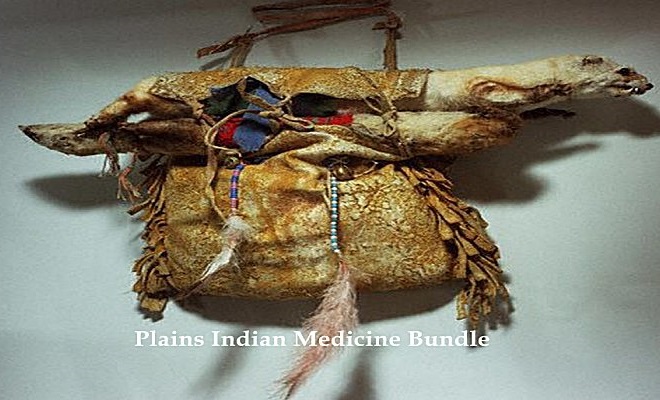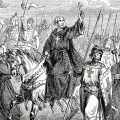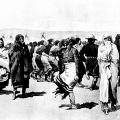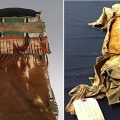
Medicine bundles are important to many of the Northern Plains tribes. The concept of “medicine” refers to spiritual power, which is not limited to healing. For the Plains Indians, spirit power—medicine—was needed for success in hunting, gambling, war, love, and other activities. The medicine bundle contains sacred objects which are symbols of spiritual power: they are not the spiritual power itself. Thus, if a personal medicine bundle is lost or stolen, the power is not lost as the individual has the power to remake the bundle.
There are basically three kinds of medicine bundles: (1) personal bundles made in accordance with instructions received from spiritual helpers during the vision quest, (2) society bundles maintained by the warrior societies, and (3) tribal bundles which are important to the entire tribe.
Among the Cheyenne, there are two sacred tribal medicine bundles: the Sacred Arrows and the Sacred Buffalo Hat.
The Sacred Arrows (Maahotse) were originally given to the prophet Sweet Medicine by Maheo (the Creator) in a holy cave within the sacred mountain (Novavose or Bear Butte). In his book Sweet Medicine: The Continuing Role of the Sacred Arrows, the Sun Dance, and the Sacred Buffalo Hat in Northern Cheyenne History, Father Peter J. Powell writes: “Sweet Medicine’s teaching is the spiritual milk by which the Cheyenne have grown in wisdom. His greatest gift to the People was Mahuts, the Sacred Arrows.”
The Sacred Arrows are living things and are the holiest of the Cheyenne tribal possessions. Father Peter J. Powell, in an article in American Indian Art, writes: “Ma’heo’o pours his life into Cheyenne lives through the Sacred Arrows. The Cheyenne people, in turn, are made one with him and with each other in him through those Sacred Arrows who bless their life and identity as a holy nation.” He goes on to say: “So perfect is that unity of the Cheyenne people with Ma’heo’o and each other through Maahotse that when a murder occurs within the Cheyenne nation, flecks of blood appears on the shafts of the Sacred Arrows.”
In his book, Father Powell summarizes the importance of the Sacred Arrows by saying: “Without the Arrows, there can be no Cheyenne tribe, no People in any supernatural sense.”
The Sacred Arrows are symbols of male power. Father Peter J. Powell reports: “No female dares look at them when they are exposed to veneration.”
Even today, women will excuse themselves from the presence of men who are speaking about the Sacred Arrows.
The Massaum Ceremony is an ancient Cheyenne ceremony which was given to the people by Sweet Medicine who first performed it at Bear Butte. The five-day ceremony re-enacts the creation of the world. During this ceremony, the Sacred Arrows are cleansed and all creation is renewed.
The second Cheyenne bundle is the Sacred Buffalo Hat (Esevone) which was a gift from Maheo to the Sutai prophet Erect Horns (Tomsivi). In historic times the Cheyenne were composed of two tribes: the Cheyenne (Tsistista) and the Sutai. The Sacred Buffalo Hat is generally associated with the Sutai who became incorporated into the Cheyenne in the late 18th century. The power of the Sacred Buffalo Hat is female. In an article in American Indian Art, Father Peter J. Powell writes: “Together, the Sacred Arrows and the Sacred Buffalo Hat form the two great covenants of the Cheyenne people.”
Through these two bundles Maheo assures continual life and blessings for the people. The people, however, must venerate and care for the bundles.
When the Sacred Buffalo Hat is renewed, those seeking a blessing stand at the edge of the old lodge cover facing the Sacred Mountain to the east. The keeper of the Hat then prays and offers the pipe to Maheo, the Earth, and the four directions. In single file, those wishing a blessing walk across the old cover to the east.
Regarding the two Cheyenne medicine bundles, George Bird Grinnell writes in his book The Cheyenne Indians: Their History and Lifeways: “So long as due reverence was paid to these relics, and the ceremonies were performed which the culture heroes had been taught and had told them must be practiced, the influence of these protective gifts was beneficial and helpful, but failure properly to respect them was certain to be followed by misfortune to the tribe.”



Leave a Reply